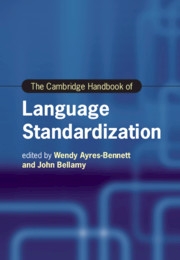Book contents
- The Cambridge Handbook of Language Standardization
- cambridge handbooks in language and linguistics
- The Cambridge Handbook of Language Standardization
- Copyright page
- Contents
- Figures
- Tables
- Contributors
- Introduction
- Part I Revisiting Models and Theories of Language Standardization
- Part II Legitimacy, Authority and the Written Form
- 7 Standard Languages in the Context of Language Policy and Planning and Language Rights
- 8 State-Appointed Institutions
- 9 Grammars, Dictionaries and Other Metalinguistic Texts in the Context of Language Standardization
- 10 An Industry Perspective
- 11 The Role of Literature in Language Standardization
- 12 Standardization, New Speakers and the Acceptance of (New) Standards
- 13 Creoles and Variation
- Part III Norms, Literacy and Education
- Part IV Beyond the National
- Part V Standardization in Late Modernity
- Name Index
- Subject Index
- References
12 - Standardization, New Speakers and the Acceptance of (New) Standards
from Part II - Legitimacy, Authority and the Written Form
Published online by Cambridge University Press: 01 July 2021
- The Cambridge Handbook of Language Standardization
- cambridge handbooks in language and linguistics
- The Cambridge Handbook of Language Standardization
- Copyright page
- Contents
- Figures
- Tables
- Contributors
- Introduction
- Part I Revisiting Models and Theories of Language Standardization
- Part II Legitimacy, Authority and the Written Form
- 7 Standard Languages in the Context of Language Policy and Planning and Language Rights
- 8 State-Appointed Institutions
- 9 Grammars, Dictionaries and Other Metalinguistic Texts in the Context of Language Standardization
- 10 An Industry Perspective
- 11 The Role of Literature in Language Standardization
- 12 Standardization, New Speakers and the Acceptance of (New) Standards
- 13 Creoles and Variation
- Part III Norms, Literacy and Education
- Part IV Beyond the National
- Part V Standardization in Late Modernity
- Name Index
- Subject Index
- References
Summary
This chapter focuses on New Speakers of minority languages and their alignment with traditionalist and modernist ideals of standardization, authority and legitimacy. First, the relevance of the New Speaker paradigm for minority languages is outlined and associated standardization processes are analysed, particularly in the cases of Breton and Irish. It is argued that while standardization initiatives in both languages were carried out with a view to modernization, the processes nonetheless took place within value-laden, traditionalist contexts. The subsequent discussion focuses on the manner in which the language practices of New Speakers of Breton and Irish have come to be associated with the standard written varieties of the languages and perceived, at times, as oralizations of written standards. This association is a fundamental feature of the language ideological landscapes of Breton and Irish and is at the heart of debates pertaining to target language varieties. In order to illustrate these tensions, the chapter shows how New Speakers of Breton and Irish can align their linguistic practices with traditionalist and modernist discourses by identifying either with a conservative dialect of either language or by not focusing on any particular established target variety in their practices or ideologies.
- Type
- Chapter
- Information
- The Cambridge Handbook of Language Standardization , pp. 347 - 370Publisher: Cambridge University PressPrint publication year: 2021



